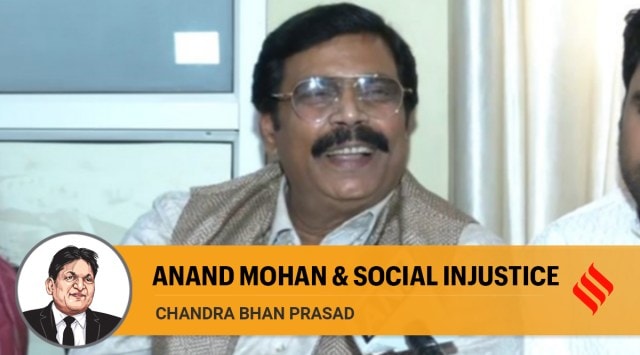
The then Collector of Gopalganj G Krishnaiah was lynched by a mob led by don turned politician, Anand Mohan on December 5, 1994, when Bihar was headed by that great mascot of social justice, Lalu Prasad. Another icon of social justice politics, now the Bihar chief minister, Nitish Kumar, facilitated the release of Mohan, who was serving a life sentence after his conviction in the Krishnaiah murder, earlier this week.
Krishnaiah died after he was attacked with stones. The symbolism of this action can transcend epochs. The Constitution triggered an era of modernity. Macaulay’s seed of rule of law was midwifed by the Crown’s baby dressed in suit and boot. An “untouchable” became the collector of lawless Gopalganj, where a stone-age public morality condemned him to death.
Krishnaiah led the Republic of India in Gopalganj. District collectors are the Republic’s emissaries on the ground; if the State has a living image at the grass roots, it is that of the Office of Collector. Hence, the slaying of the district collector was nothing but an attack on the Republic. The killer surely would have known the social background of the collector. He deserved the gallows. Instead, the Republic’s enemy has been granted freedom.
This attack on the Republic took place in the reign of social justice. Social justice ideologues have gone into hiding since. And for Dalit thought-leaders, to borrow the late Chandan Mitra’s term, their silence is akin to rewarding the oppressors. Dalits have been rewarding Lalu Prasad for long.
Contemporary India has refused to confront two inflexible truths. One, there is no social audit of the social justice doctrine. Two, Dalit thought-leaders behave like rain-time flying termites that are attracted to street lights, which cause their death. The OBCs are like the street lights.
Until the implementation of the Mandal Commission, my wisdom tells me, Indian society had reconciled with the ideals of Dalit/Adivasi rights and affirmative action. Mandal shattered that consensus. Yet, Dalits continued to sing in praise of Mandal. The fireflies ignored that B P Mandal, who chaired the Mandal Commission, had humiliated the only Dalit member in the Commission, L R Naik. Naik had advised the Commission to split the OBC quota into two — Extremely Backwards (artisans) and Backwards (farmer OBCs). His idea was rejected and Naik refused to sign the Mandal Commission’s recommendation. Instead, he submitted a note of dissent. Has it ever bothered the Dalit thought-leaders that the Mandal Commission recommendations do not have the Dalits’ consent? Have the thinking Dalits turned savarna/upper caste phobic, willing to sacrifice everything for the sake of OBCs?
Dalits got excited with Lalu Prasad’s Bhura Bal theorem? Is there any evidence that the ruin of savarnas will lead to Dalit emancipation? What is the situation of Dalits in Tamil Nadu that ended Brahmin hegemony decades ago? I am yet to find any rational explanation for the Dalit love of anti-Brahmin rhetoric.
What Dalits haven’t figured out, and what social justice apologists do not explain, is this: That the two rising social forces tend to compete amongst themselves, not cooperate. The competition can easily degenerate into collisions. Dalits and OBCs are the two greatest beneficiaries of the Republic’s resolve. While Dalit intellectual tradition seeks the annihilation of caste order, the OBC tradition seeks mere removal of savarnas from the political power structure and public institutions and imposition of their own hegemony. The Dalits fail to comprehend that once empowered, the OBCs look for a praja and Dalits become the target. The “neo-Thakurs” seek the status of the original Thakur without Thakur like benevolence; the empowered OBCs demand salaams which the Dalits refuse. This Dalit resilience pushes them into conflict with the OBCs.
My life experience finds the OBCs to be least argumentative as a social class. Mention L R Naik and OBC thinkers turn suspicious of you. Mention the UP guest house episode, their eyes turn red. Refer to allegations of Akhilesh Yadav demoting countless Dalit officers and the OBC intellectuals walk away.
Now, let’s do a social audit of social justice! When Rajiv Gandhi became Prime Minister in 1984, Lalu Prasad was just 36 years old. Rajiv’s first major governance initiative was satellite-based distance education. Primary schools were fitted with colossal antennas and TV sets were provided in class rooms. In absence of electricity, the experiment failed. He then set up IGNOU, one of the world’s largest distance learning institutions. The Jawahar Navodaya Vidyalayas are among the most successful experiments in nourishing talent from rural India. The Navodayas often outshine the best of the public schools and the Navodiyans are now spread all over the world. Needless to mention the IT revolution that Rajiv Gandhi unleashed.
What are the initiatives that social justice politicians launched? Charvaha Vidyalay. The OBC mascots couldn’t rise above their “buffalo nationalism”; the doctrine is simple — consume as much as of what has been created in the past, create nothing new.
Now that the Indian National Congress has also extended its hand to the social justice politicians, the nation’s ruin is unstoppable. The Congress must note that social majoritarianism can be as dreadful as religious majoritarianism.
The writer is an Affiliate Scholar with Mercatus Center, George Mason University, US